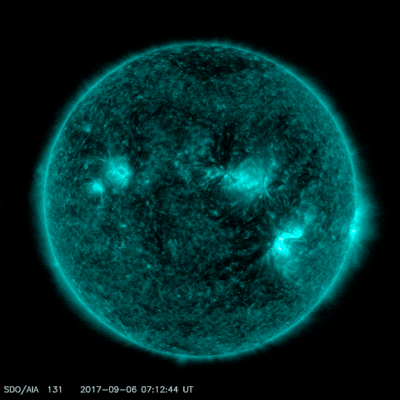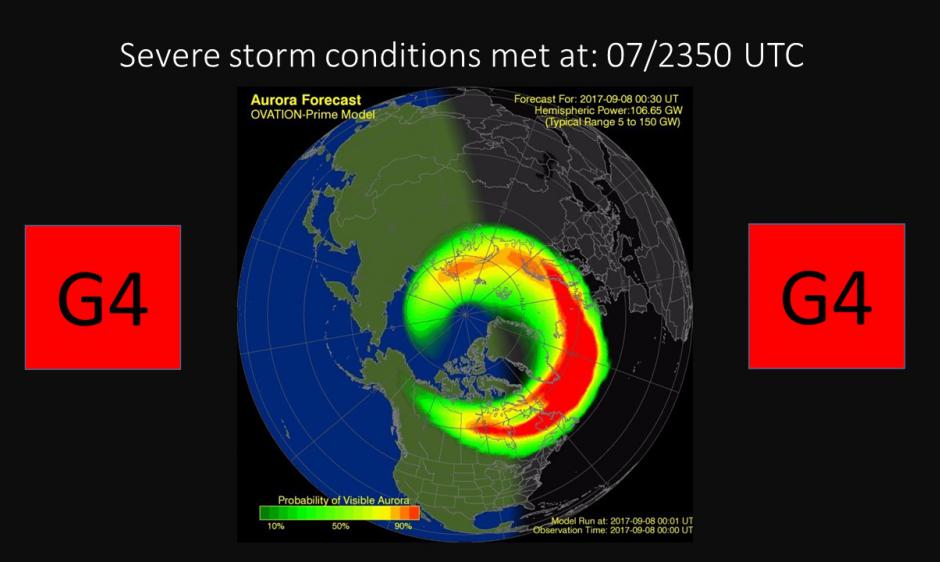|
The recent solar activity can give us the opportunity to see the Northern Lights in latitudes more to the south than usual. Last Wednesday, September 6th, the Sun had two big flares ejecting a lot of material through space. The dynamics of the interior of the Sun is not yet fully understood. We know that the activity increases and decreases in periods of 11 years. We are now leaving a minimum of activity. Last week we could see a couple of big spots on the surface of the Sun, indicating activity. The spots that the Sun present are regions of lower temperature (~4000K versus ~6000K). They are due to the flux of material in the inside of the Sun due to the interaction of intense magnetic fields and important gradients of temperature. The core of the Sun is at about 10 million degrees while the surface is at about 6000 degrees. This week two big flares have been ejected from the Sun. This flares are energetic particles that the Sun emits, basically protons and electrons, that travel at high speeds and can reach the Earth in about two days. This gives us some small time to forecast its effects on our atmosphere.
When these energetic particles reach the Earth they interact with the molecules of the atmosphere, oxygen, nitrogen, carbon. This interaction ends up emitting light of different color (reddish and greenish), depending on the molecule they interact with.
29 Comments
5/9/2022 13:26:00
Really informative article, I had the opportunity to learn a lot, thank you. https://freecodezilla.net/autocad-2010-free-download-cracked/
Reply
11/9/2022 16:45:41
Really informative article, I had the opportunity to learn a lot, thank you. https://kurma.website/
Reply
14/9/2022 19:35:22
Really informative article, I had the opportunity to learn a lot, thank you. https://bit.ly/site-kurma
Reply
5/10/2022 02:37:02
I think this post is useful for people. It has been very useful for me. Looking forward to the next one, thank you. https://escortnova.com/escort-ilanlari/kirikkale-escort/sulakyurt-escort/
Reply
5/10/2022 04:37:58
It was a post that I found very successful. Good luck to you. https://escortnova.com/escort-ilanlari/trabzon-escort/duzkoy-escort/
Reply
6/10/2022 01:13:23
I follow your posts closely. I can find it thanks to your reliable share. Thank you. https://escortnova.com/escort-ilanlari/ankara-escort/kizilcahamam-escort/
Reply
6/10/2022 16:50:07
I support your continuation of your posts. I will be happy as new posts come. Thank you. https://escortnova.com/escort-ilanlari/canakkale-escort/biga-escort/
Reply
7/10/2022 01:38:23
I think the content is at a successful level. It adds enough information. Thank you. https://escortnova.com/escort-ilanlari/hakkari-escort/
Reply
7/10/2022 15:42:35
Thank you for your sharing. I must say that I am successful in your content. https://escortnova.com/escort-ilanlari/denizli-escort/pamukkale-escort/
Reply
21/11/2022 22:02:52
Tıkla evde calismaya basla: https://sites.google.com/view/evden-ek-is/
Reply
9/12/2022 21:15:46
Düşmeyen bot takipçi satın al: https://takipcialdim.com/
Reply
10/12/2022 00:13:50
İnstagram beğeni satışı yapan firmamıza göz atın: https://takipcialdim.com/instagram-begeni-satin-al/
Reply
10/12/2022 00:18:42
Tiktok takipçi satışı burada: https://takipcialdim.com/tiktok-takipci-satin-al/
Reply
15/12/2022 19:27:00
uygun fiyatlardan takipçi Hemen Göz At: https://takipcim.com.tr/
Reply
8/1/2023 16:03:59
100 tl deneme bonusu veren siteleri öğrenmek istiyorsan tıkla.
Reply
30/6/2023 17:14:17
En iyi hakkari ilan sitesi burada. https://hakkari.escorthun.com/
Reply
Leave a Reply. |
Andrés AragonesesPhysicist, working in quantum optics and nonlinear dynamics in optical systems. Loves to communicate science. Archives
January 2018
Categories |


 RSS Feed
RSS Feed
